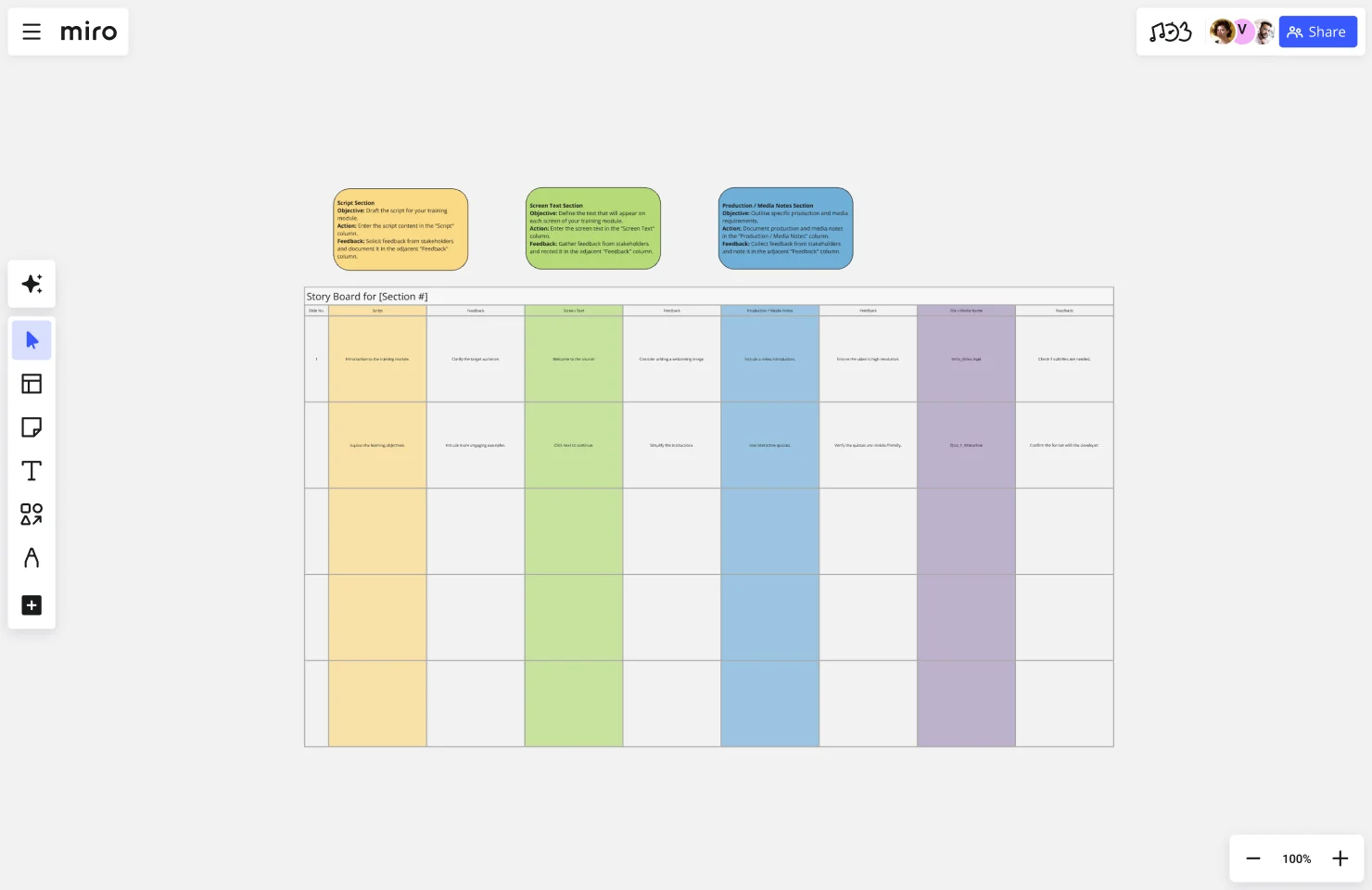Storyboard for Educational Purposes Template
The storyboard for educational purposes template streamlines course creation by organizing content into scripts, screen text, and production notes, fostering collaboration among educators and trainers to enhance learning outcomes.
About the Storyboard for Educational Purposes Template
The "Storyboard for Educational Purposes" template is designed to streamline and enhance the instructional design process by fostering collaboration between instructional designers and stakeholders across an organization. This template ensures that all essential details are captured and feedback is systematically collected, leading to more effective and engaging training courses.
Template Sections:
Script
Description: This section is for drafting the script of the training module.
Purpose: To outline the narrative and instructional content.
Feedback: Provides a space for stakeholders to review and suggest improvements.
Screen Text
Description: This section captures the text that will appear on each screen of the training module.
Purpose: To ensure clarity and alignment with the instructional design.
Feedback: Allows stakeholders to suggest edits for better comprehension and engagement.
Production / Media Notes
Description: This section details specific production and media requirements.
Purpose: To guide the creation of multimedia elements such as videos, graphics, and interactive components.
Feedback: Ensures that stakeholders can provide input on the technical and creative aspects.
File / Media Name
Description: This section is for naming the files and media assets used in the training module.
Purpose: To organize and standardize the naming conventions for easy identification and retrieval.
Feedback: Allows stakeholders to verify and suggest names for consistency and clarity.
Why Use This Template?
Facilitates Collaboration: This template encourages active participation from stakeholders, ensuring that their insights and feedback are incorporated throughout the instructional design process. This leads to more comprehensive and well-rounded training materials.
Enhances Clarity and Organization: By breaking down the storyboard into specific sections, this template helps instructional designers organize their content systematically. It ensures that all aspects of the training module are well-documented and easy to review.
Improves Training Effectiveness: Collecting feedback at each stage of the design process ensures that potential issues are identified and addressed early. This iterative feedback loop helps create training courses that are more engaging, effective, and aligned with organizational goals.
Streamlines Production: Clear documentation of scripts, screen text, production notes, and file names simplifies the transition from design to production. This helps in delegating tasks efficiently and reduces the risk of miscommunication and errors.
Promotes Accountability: By documenting feedback from stakeholders, this template promotes accountability and ensures that all voices are heard. It creates a transparent process where feedback is tracked and acted upon.
Saves Time and Resources: Having a structured template reduces the time spent on organizing and gathering feedback manually. It allows instructional designers to focus more on content creation and less on administrative tasks.
Conclusion
The "Storyboard for Educational Purposes" template is a valuable tool for any organization looking to create effective training courses. It enhances collaboration, improves organization, and ensures that all feedback is captured and acted upon. By using this template, instructional designers can create engaging and impactful educational content that meets the needs of their learners and aligns with organizational objectives.
Get started with this template right now.
Design Sprint Kit Template
Works best for:
Agile Methodology, UX Design, Sprint Planning
With the right focused and strategic approach, five days is all it takes to address your biggest product challenges. That’s the thinking behind Design Sprint methodology. Created by Tanya Junell of Blue Label Labs, this Design Sprint Kit provides a set of lightweight templates that support the Design Sprint’s collaborative activities and voting—and maintains the energy, team spirit, and momentum that was sparked in the session. Virtual sprint supplies and prepared whiteboards make this kit especially useful for remote Design Sprint Facilitators.
Diary Template
Works best for:
Design
The Diary Template is an effective research tool to gain insights into individuals' internal processes as they document their encounters with a specific product, service, or matter. Unlike real-time interactions, journaling is usually conducted asynchronously over an extended period of time, enabling deliberate reflection that other methods may not facilitate. This asynchronous nature encourages individuals to express more elaborate accounts of their emotions and viewpoints, resulting in profound and stimulating responses.
Discovery Interviews Template
Works best for:
Design, UX
The Discovery Interviews Template is a powerful tool that allows you to delve into a topic from different angles and gain a deeper understanding of different perspectives. By conducting interviews using this template, you can uncover valuable insights and uncover new information that can help you make informed decisions. Whether you are a researcher, product manager, or simply curious about a specific topic, the Discovery Interviews Template is an essential resource for anyone looking to explore a subject in depth.
Service Blueprint to connect journey & operations
Works best for:
Research & Design
Connect customer journeys with operational processes using the Service Blueprint by Essence. This template helps you map out service interactions and backend processes, ensuring seamless service delivery. Use it to align teams, identify gaps, and enhance the customer experience. Perfect for visualizing the entire service ecosystem and improving coordination between different service components.
Dot Voting Template
Works best for:
Design
The Dot Voting Template is an excellent tool to gather input from all participants, enabling each person to express their preferences and opinions before reaching final decisions. Voting acts as an incentive, driving quick discussions and pushing your team forward in project development.
UX Research Repository Template
Works best for:
UX Design, User Experience
Empower your organization with customer knowledge and build a centralized research hub. From UX designers to product managers, enable everyone to get insights using the Research Repository Template.
